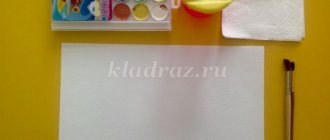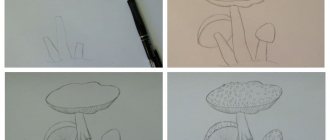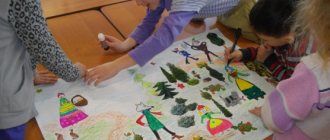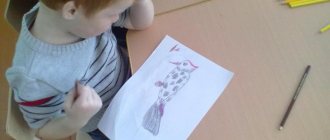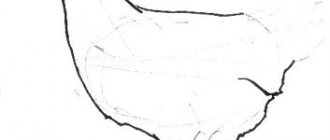Aspects of drawing on the topic “Fairytale houses” in the senior group of preschool educational institutions
In the senior preschool level, most children are already quite good at drawing and creating beautiful and expressive images. By observing the world around them, preschoolers learn to draw houses (subject drawing) and plot compositions on a given topic (“My city”, “Houses on our street”). However, at this age, the teacher should pay great attention to the development of children’s creative independence. Therefore, as part of the “House” theme in older groups, children quite often draw a variety of houses. These images are borrowed from Russian and foreign fairy tales, and are also the fruit of children's imagination.
As practice shows, such works are not similar; each child creates his own unusual image at home. Such compositions are often plot-based - complemented by various kinds of details: trees, sun, clouds, fairy-tale or fictional characters, etc.
During the drawing process, the teacher makes sure that the children harmoniously position the image on the paper and maintain proportions (objects that are located far away should be smaller). In addition, the child must position the sheet of paper correctly: vertically if the house is tall, horizontally if it is low and wide.
As a rule, the image of a house is made up of geometric shapes (a square or rectangle of a triangular roof). Children 5–6 years old can already draw these figures quite well.
Preschoolers already know that objects can partially block each other. For example, there may be a tree growing in front of the house.
The theme “Fairytale Houses” offers a wide choice of colors. After all, such buildings can be of a variety of colors. Here everything depends only on the scope of the child’s imagination.
Since drawing fairy-tale houses is a creative activity, a teacher’s example is not required here—illustrations (there should be several of them) from fairy tales and an explanation of the basic techniques of work are enough.
The teacher should pay great attention to the analysis of children's drawings. So, when the work is finished, you can invite the children to talk about their drawing and evaluate the compositions of their friends. Moreover, the teacher must lead children away from unambiguous assessments (“like” - “dislike”).
Materials used and base
In the older group, children draw houses from fairy tales on sheets of paper of the usual size (A4). When working with paints, the teacher tints the base in advance. It can be pastel colors, or a combination of blue and green (sky and grass).
If preschoolers draw a house with pencils, then they draw the background themselves (no preliminary tinting of the base is required).
Note that compositions on this topic are equally good to draw with both paints (gouache or watercolor) and colored pencils. Pencils make it easier to draw and color various small details. The gouache drawing turns out bright and rich.
Note that when depicting fairy-tale houses, preschoolers, as a rule, choose the materials themselves. A combination of materials is often used. For example, the house itself, tree crowns, clouds, the sun can be painted in watercolors, and various small details, for example, logs, tree branches, rays of the sun are drawn with felt-tip pens - the drawing only benefits from this. Similarly, pencils are combined with felt-tip pens.
Drawing with watercolors and felt-tip pens
Drawing with watercolors and felt-tip pens
When drawing a fairy-tale house, a simple pencil is often used to preliminary mark the outline.
Drawing techniques and techniques to use
When drawing on this topic, preschoolers in the senior group reinforce drawing techniques with a variety of visual materials.
As for a simple pencil, the guys improve the skill of drawing a contour with light pressure, avoiding the appearance of rough lines that spoil the image.
While working with colored pencils, children continue to learn how to convey different shades of color (from pastel to rich) using pressure. At this age, preschoolers are able to convey up to three shades of images in this way.
When drawing a house in watercolors, the teacher draws the children's attention to the fact that the transparency of the color can be adjusted. Children should learn that a deeper shade is obtained if the brush is almost dry, and a blurred shade is obtained by adding more water. If gouache is used for the image, then the children learn to mix paints to obtain interesting shades.
Preschoolers improve different ways of painting with a brush: with the whole bristle - when painting large details and drawing wide lines, and with the tip - for drawing small elements.
Additional types of visual activities used, the relevance of an individual approach
Since “Fairytale House” is a creative, often fantasy theme for a drawing lesson, children should not be limited in the choice of materials that can be used in the process of work. So, the windows of a magic house can be cut out of shiny foil. Grass made of colored paper, clouds made of cotton wool or cotton pads will complement the composition in an original way. And to make the houses joyful and bright, you can draw the sun using the plasticineography technique.
If the theme of the drawing is “Gingerbread House,” then applique details made from candy wrappers would be very appropriate in such a composition.
As for the individual approach in the lesson, the teacher can offer capable children who finish their work earlier than others to depict fairy-tale characters near the house, for example, the three little pigs, Baba Yaga, a hare and a fox, etc. (depending on the chosen fairy tale).
Specific options for compositions within the theme “Fairytale houses”
Drawing of fairy-tale houses is offered to children in the senior group in the first half of the year (November) after the application “Houses on our street.” This is a fantasy work: preschoolers draw houses from fairy tales they know (“Teremok”, “Rukavichka”, “Jug”, “Gingerbread House”). As part of this theme, many children depict a hut on chicken legs in which the evil Baba Yaga lives. The teacher first discusses with the children that such a hut is very old, made of logs, all lopsided, its roof is covered with tree branches, straw, moss, and there is a small window.
A little later (in February), the senior group students are offered the theme “Houses of the Three Little Pigs.” This is a drawing based on the plot of an English folk tale. The teacher recalls this fairy tale with the children, finds out which houses the piglets built (from straw, twigs, stones). It is specified that every house must have walls, a roof and windows. The composition, as a rule, is complemented by trees, grass, and flowers.
Photo gallery: pictures from fairy tales
Illustration for the fairy tale “The Three Little Pigs”
Illustration for the fairy tale “The Three Little Pigs”
Illustration for the fairy tale “The Three Little Pigs”
In the spring (March), preschoolers create another composition on the theme of a fairy-tale house - “The bunny had a bast hut, and the fox had an ice hut.” This is a plot drawing based on the fairy tale “The Fox and the Hare”. Note that this topic can be divided into two classes: first, the children depict the huts of forest animals, complemented by an appropriate background; in the next lesson, animals are drawn.
At the beginning of the lesson, the teacher recalls with the preschoolers the plot of this Russian folk tale and clarifies what the huts of the fox and the hare were built from.
In addition to these topics, you can offer children such fantasy works as “House for Little Dwarves.” An interesting topic is drawing houses endowed with anthropomorphic features: with eyes, a smile. They may also have hands, a hat, etc. Such an activity can be called, for example, “Sad House” or “Happy House”, “Smile at Home” (based on the Iris Review fairy tale)..
Notes on drawing lessons for the senior group of fairy-tale houses
| Author's full name | Title of the abstract |
| Golysheva I.V. | "A hut on chicken legs" Educational objectives: learn to draw a fairy-tale image - a hut on chicken legs, recreate the texture of wood using thin lines and shading. Developmental tasks: to improve the ability to draw with paints and the technique of working with wax crayons, to better acquaint preschoolers with the work of Yu. Vasnetsov. Educational tasks: to cultivate interest in art. Integration of educational areas: “Artistic creativity”, “Cognition”, “Communication”, “Socialization”, “Health”. Demo material: Baba Yaga's hut made of cardboard, illustrations by Yu. Vasnetsov, audio recording “The Road of Good”. Handout: sheets of white paper according to the number of children, watercolors, sippy cups, brushes, coasters, napkins, wax crayons. Progress of the lesson: To the sounds of the song “The Road of Goodness” there is a knock on the door - Baba Yaga’s hut (an adult in disguise) enters. The hut reports that it ran away from its owner. She asks the guys to repair it, put it in order, since it has become creaky and is about to fall apart (motivation). The children agree to help - draw a new hut and decorate it further. The teacher shows the children illustrations by the Russian artist Vasnetsov - little goat's huts, bunnies, kitties. Children examine them and note the beautiful carved frames on the windows. Baba Yaga's hut also wants to become just as beautiful. The teacher reminds the children of a schematic representation of a hut (the base is a square and a triangular roof) and explains how to display wooden logs in a drawing (a number of ways). A physical education session “Here are my helpers” is held (the hut also does exercises, as her chicken legs are numb).
Independent work of children. The teacher helps some children decide on drawing techniques and encourages them to decorate the fairy-tale image. At the end of the lesson, the teacher asks the preschoolers what new things they learned in the lesson (to draw wooden logs), what was most difficult, what helped them overcome difficulties, and where the ability to draw logs may be useful. The hut chooses the drawings that she liked best and returns back to the magical land. She reports that Baba Yaga will become kinder from such beautiful works. |
| Mitina I.V. | “Fairytale House” The lesson begins with reading an excerpt from a fairy tale about the Flower City. Short people lived there. Everything in the city was very beautiful and there were unusual intricate houses. Their roofs had different shapes, they even looked like flower buds. The teacher invites the children to imagine themselves as residents of this amazing city and imagine their home. The didactic game “Build a House” is played (children build houses from building material). After performing finger exercises, the teacher invites the children to draw houses (using templates) and turn them into fairy-tale ones. To do this, you need to decorate them with patterns, draw a beautiful ladder, flowers, etc. |
| Medvedeva V. | "The Three Little Pigs' House" The lesson has an unusual beginning - the teacher asks preschoolers to name fairy tales that have the number “three” in their titles. And to find out which fairy tale needs help, you need to guess the riddle:
Discussion on the content of the fairy tale “The Three Little Pigs.” The teacher discusses with the children what materials the houses of Nif-Nif, Naf-Naf and Nuf-Nuf were built from. The teacher talks about the characteristics of straw (it is weak, afraid of fire and even weak winds). A house made of twigs is, of course, stronger, but a strong wind will destroy it. But a stone house is the most durable. The teacher invites the children to draw piglets' houses using templates so that they fit on a sheet of paper. They need to be painted so that the key features of each material are visible. For example, straw is depicted with thin vertical strokes. Physical education is being held
Independent activity of children. Analysis of works. |
| Karaseva E. | “The bunny had a bast hut, and the fox had an ice hut” The lesson begins with the game “On the contrary” (children stand in a circle and name antonyms for words, for example, “big”, “bitter”, “loud”, etc.) The phone rings: her friend Zabyvaikin calls the teacher. He ended up in the Land of Fairy Tales and the queen imprisoned him because he could not remember the fairy tale “Zayushkina’s Hut” (it was necessary to draw illustrations for it). The guys must help Zabyvaikin out (motivation) - draw the huts of the fox and the hare. Children go to the Land of Fairy Tales on a magic carpet. They meet the Scientist Cat there, who will let the guys through if they tell him how to get brown and blue, gray and orange from other colors. Then the preschoolers see the Queen of Fairy Tale Land. She asks them questions about the plot of the fairy tale “Zayushkina’s Hut” Preschoolers draw illustrations for a fairy tale. The Queen releases Zabyvaikin. |
Drawing a room with furniture
The second example will be a little more complicated, and if you have coped with the previous one, then you can move on to this and figure out how to draw a room with furniture and light and shade. We will not color this drawing, but will apply professional chiaroscuro to it.
As last time, at the first stage we must draw boundaries. Everything is simple here, two intersecting lines in the center and a rectangle.
Let's draw a volumetric passage to another room and lay the foundation for future tiles on the floor in the form of vertical stripes.
We draw the next room, note that the line that we drew in the first stage is the corner of the ceiling of the next room. Also, we are working on the window, the right passage and the horizontal stripes for the tiles.
We fill the room with furniture and add a table and chair. Let's draw small details, such as the door and window frame.
Now we apply chiaroscuro and erase the auxiliary lines. This is a very difficult stage and to understand it we recommend watching the video tutorial.
Examples of completed student work with comments on the completion of the work
As practice shows, preschoolers really like to draw a hut on chicken legs, in which the evil Baba Yaga lives. After all, negative characters in fairy tales always attract the attention of children.
The composition “Baba Yaga's Forest Hut” conveys the atmosphere of a dark, gloomy forest. But the work “The Hut on Chicken Legs,” on the contrary, exudes a joyful, positive mood: the sun is shining brightly, flowers are blooming, and mushrooms are growing.
The hut in the drawing “Geese and Swans” seems to have started dancing; the image is complemented by Baba Yaga’s stupa and broom and flying birds from the fairy tale of the same name.
Of interest is the work “Babya Yaga’s Hut”, which includes applique details: these are the logs of the house (their coloring imitates a tree), a window (painted with beautiful patterns). The background, sun, grass, trees and flowers are drawn with colored pencils. An original detail - red fly agaric mushrooms grow on the roof of the hut.
Photo gallery: ready-made drawings for preschoolers
Watercolor drawing
Drawing with pencils
Drawing with pencils
Drawing with applique elements
Children always empathize with the bunny from the fairy tale “Zayushkina’s Hut” and enjoy drawing illustrations for this fairy tale. The compositions “Ice and Bast Hut” and “Two Houses” well convey the process of melting the sly fox’s ice house. In addition, the drawing “Two Houses” depicts animals very realistically. And the work “Ice and Bast Hut” has an unusual background - shimmering blue and blue colors.
In the work “The House of the Fox and the Hare,” the huts and trees look interesting thanks to the use of different shades of the same color of watercolor paint (this effect is achieved due to different degrees of transparency of the same color).
The composition “The Hut of the Hare and the Fox” well reflects the log structure of the bunny’s bast house.
Photo gallery: children's drawings
Watercolor drawing
Drawing
Pencil drawing
Watercolor drawing
Pencil drawing
“The Three Little Pigs” is one of our favorite children's fairy tales. Many works very well convey the material from which the characters’ houses are built. In this regard, the composition “Houses of Naf-Naf, Nif-Nif and Nuf-Nuf” is noteworthy, where straw and stone are realistically depicted using various techniques (painting with the tip of a brush). In the drawing “The House of the Three Little Pigs” this effect is achieved by using different shades of the same color (pink stone house) and drawing contrasting lines.
An interesting drawing is “Three Houses”, where smoke comes out of the chimneys in one direction.
Watercolor drawing
Watercolor drawing
Pencil drawing
Pencil drawing
Drawing with pencils and felt-tip pens
Interpretations on the theme “Teremok” deserve attention. The work “My Favorite Teremok” is distinguished by its bright color scheme and the complexity of the painted structure. And the photo exhibition “Fairytale House” demonstrates that preschoolers were given the right to choose materials for work: all the houses are interesting in their own way, decorated with fancy patterns.
Drawing with watercolors and felt-tip pens
Pencil drawing
Let’s also consider fantasy works on the theme “Fairytale House”, which are not tied to any specific fairy tales. These are beautiful palaces with towers and lattice windows. The composition “Ice Castle” can be interpreted as the castle of a snow queen, especially since it is decorated with snowflakes, two snowmen stand guard and there is a snowy background.
In the work “Fairytale Palace” we note the careful drawing of the lines and the beautiful coloring of the sky, reminiscent of the northern lights.
Room plan
The last example is very different from the previous ones and will show us how to draw a room plan with a top view. Such plans are often found in construction or renovation, when the location of certain elements is planned.
We take a pencil and lie down by pressing it and make a simple sketch. It is not necessary that the lines be perfectly straight at this stage; it is enough to make a rough concept of the future plan.
The next step is much more important; we will need a black felt-tip pen and a ruler. The walls are depicted with a thick line, and the windows with a thin line. To draw a door on the plan, you need to draw a stick from which dotted lines extend, reflecting its movement.
Using an eraser, we erase all the auxiliary elements that we made with a pencil. Then we sign the names of the rooms and the drawing can be considered ready.
Based on this example, you can draw a plan for your room, apartment or house.
Shows in detail how to draw a room.
